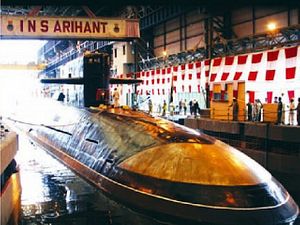Earlier this week, India’s first indigenously developed ballistic missile nuclear submarine (SSBN), the INS Arihant, began its sea trials. The 6,000-ton nuclear-powered submarine represents a major milestone in India’s efforts to indigenize advanced defense production. The Arihant will be an important component of India’s nuclear triad (the ability to deliver a nuclear strike by land, air, and sea). Each Arihant-class submarine (two or three more will be produced) will field up to 12 K-15 submarine-launched ballistic missiles (SLBMs) with a 700-750 km range, with an upgrade planned for a K-4 SLBM capability. The K-4 has a range of up to 3,500 km and is currently in testing.
India’s new Defense Minister Manohar Parrikar presided over the inauguration of the INS Arihant‘s sea trials, which will take place off the country’s eastern coast, in the Bay of Bengal. The Hindu notes that the Arihant pulled out of Visakhapatnam Harbor, a major Indian shipyard. In addition to the defense minister, Indian Navy Chief of Staff Admiral R. K. Dhowan, other senior defense officials, and Indian nuclear scientists were present at the ceremony at Visakhapatnam. IHS Jane’s 360 notes that the date of December 16 for the initiation of sea trials was no coincidence: according to Parrikar, the date was chosen for its significance as the day Pakistan formally surrendered to India in 1971, ending a war between the two neighbors that resulted in the creation of Bangladesh.
The initiation of Arihant‘s sea trials will be a breath of relief for observers of Indian defense issues as the project was set back by multiple delays. The inception of the Advanced Technology Vehicle (ATV) submarine program — the name of the program that led to the development of the Arihant — dates back to 1984. The submarine itself was formally launched in 2009 to much fanfare. Now, five years later, it finally began sea trials. The most compelling signal that sea trials would begin in due time was when the Arihant‘s reactor went critical in August 2013. However, it took over a year for these sea trials to begin.
Nevertheless, the sea trials bring India one step closer to operationalizing its SLBM capability, bringing it into the ranks of the United States, Russia, China, France, and the United Kingdom as the only countries with a credible sea-based nuclear deterrent. Despite the optimism inspired by the Arihant, India’s overall submarine fleet remains relatively outdated and most vessels will near the end of their 25-year lifespan by 2017.

































